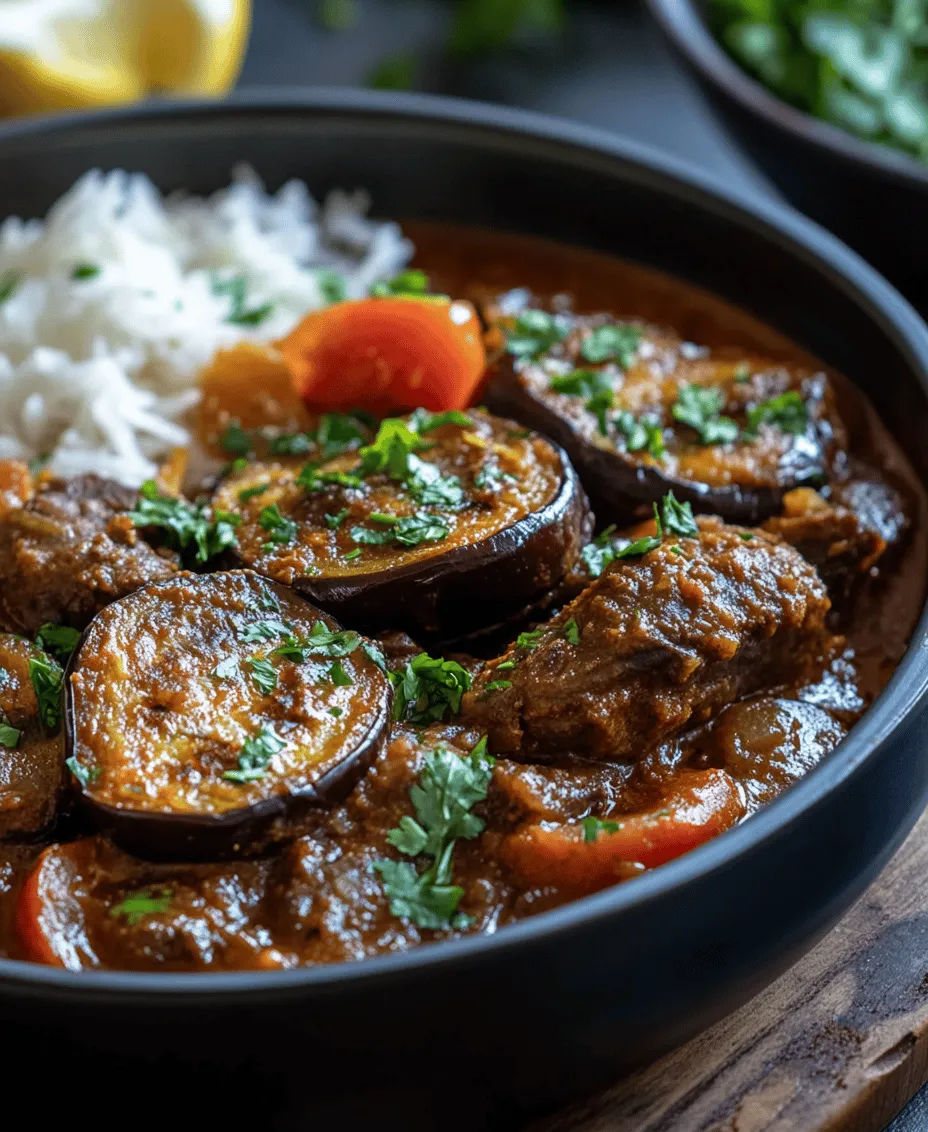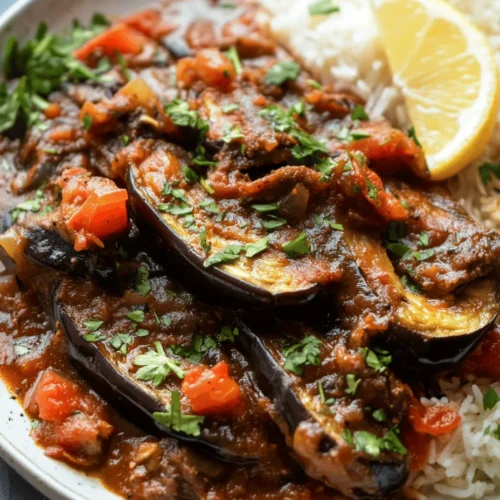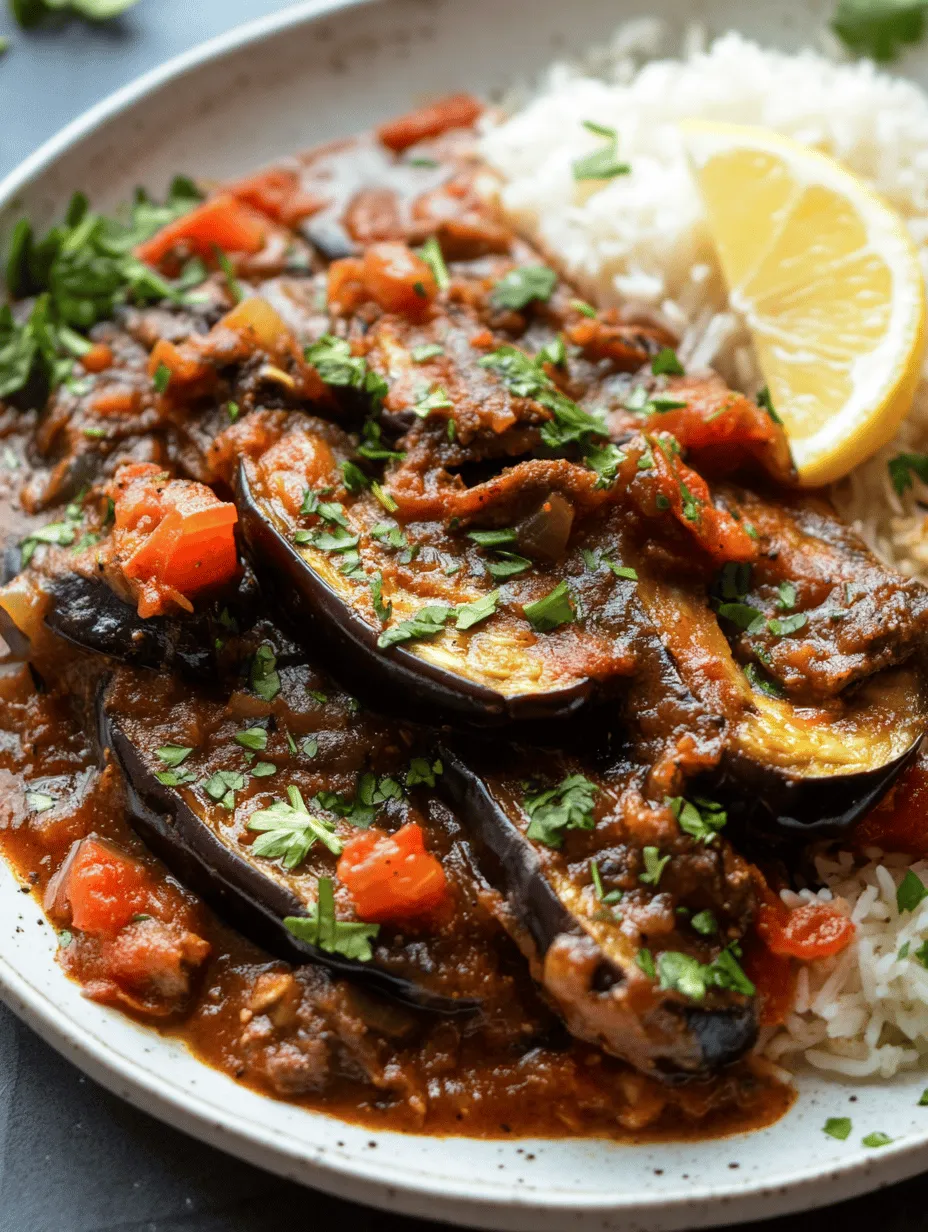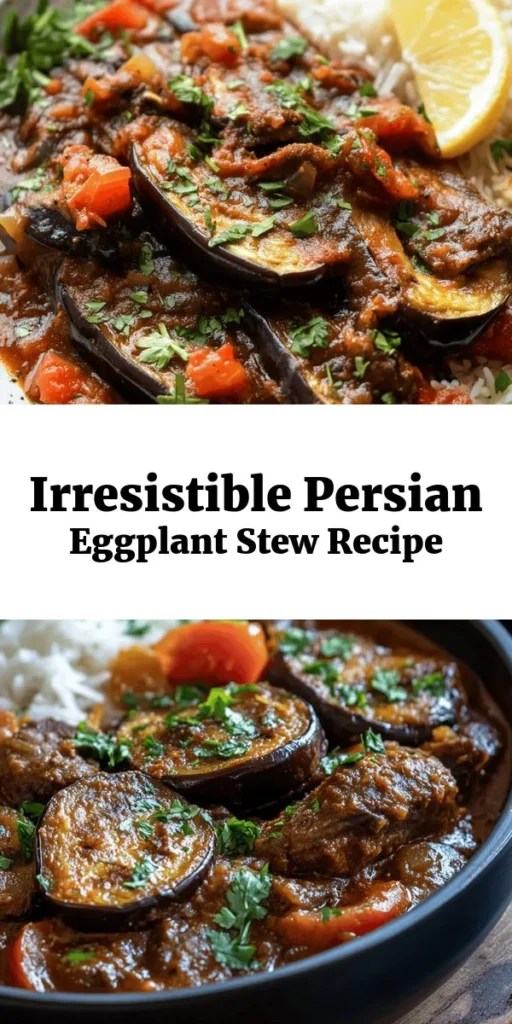Introduction to Khoresh Bademjan: The Heart of Persian Cuisine
Khoresh Bademjan, a beloved staple of Persian cuisine, embodies the rich culinary heritage of Iran. This traditional stew, characterized by its luscious eggplant and tender meat, captures the essence of Persian flavors, offering a delightful combination of textures and tastes that make it a favorite among food lovers. Often served alongside steaming basmati rice, Khoresh Bademjan is not just a meal; it is an experience that connects people to the heart of Persian culture.
The origins of Khoresh Bademjan can be traced back centuries, deeply rooted in the agricultural practices of the Persian Empire, where the fertile lands provided an abundance of vegetables and spices. Eggplant, known as “bademjan” in Persian, has played a significant role in Iranian cooking due to its versatility and ability to absorb flavors, making it an ideal ingredient for stews. The cultural significance of eggplant extends beyond its culinary uses; it symbolizes the creativity and resourcefulness of Persian cooks who have perfected the art of transforming simple ingredients into exceptional dishes.
As you delve into Khoresh Bademjan, prepare to be enveloped in vibrant flavors that dance on your palate. The stew is infused with the warmth of spices, the richness of meat, and the velvety texture of eggplant. Each bite offers a harmony of sweet and savory notes, punctuated by the aromatic herbs that garnish the dish. It is a celebration of nature’s bounty, showcasing the beauty of seasonal produce and the importance of fresh ingredients in Persian cooking.
Understanding the Ingredients: A Closer Look at Khoresh Bademjan
The Role of Eggplant in the Recipe
Eggplant is undeniably the star of Khoresh Bademjan. This versatile vegetable not only adds depth to the dish but also contributes a unique texture that enhances every spoonful. In Persian cuisine, eggplant is revered for its ability to absorb flavors, making it a perfect companion for the spices and meats used in stews. When cooked, it transforms into a creamy, rich component that balances the heartiness of the meat.
Nutritionally, eggplant is a powerhouse. It is low in calories yet high in fiber, making it a wonderful addition to a balanced diet. Rich in antioxidants, particularly nasunin, it promotes heart health and contributes to overall well-being. Moreover, eggplant is a source of vitamins C and K, along with various B vitamins that support metabolic processes.
When it comes to varieties, Persian cuisine primarily utilizes globe eggplants due to their mild flavor and meaty texture. However, smaller varieties like Japanese or Chinese eggplants are also gaining popularity for their sweetness and tender skin. Each type brings its own unique quality to Khoresh Bademjan, allowing cooks to experiment and personalize the dish according to their preferences.
Choosing the Right Meat
The choice of meat in Khoresh Bademjan can significantly influence the dish’s flavor profile. Traditionally, lamb is preferred for its rich taste and tenderness, which meld beautifully with the other ingredients. The natural fats in lamb render during cooking, creating a luxurious stew that coats the eggplants and enhances the overall experience.
Alternatively, beef can be used for those who prefer a heartier option. While it may not yield the same depth of flavor as lamb, selecting high-quality cuts can still produce a satisfying stew. When choosing meat for Khoresh Bademjan, look for cuts that are well-marbled, as the fat content will contribute to the stew’s richness.
To ensure the best results, consider sourcing meat from local butchers who prioritize quality. They can provide insights into the best cuts for stews and may even offer organic or grass-fed options. This not only supports local businesses but also guarantees that you’re using the freshest ingredients in your cooking.
The Aromatic Base: Onions and Garlic
The foundation of Khoresh Bademjan is built on the aromatic duo of onions and garlic. These ingredients are essential for flavor development, providing a savory base that enhances the entire dish. Sautéing onions until they are translucent and golden caramelized releases their natural sweetness, which balances the earthiness of the eggplant and the richness of the meat.
Garlic, on the other hand, adds a robust flavor that elevates the stew’s aroma. When sautéed alongside the onions, it releases essential oils that permeate the dish, creating a fragrant backdrop that draws you in. Both ingredients are crucial for achieving the depth of flavor that Khoresh Bademjan is known for, making them indispensable in the cooking process.
Spices that Make a Difference
The magic of Khoresh Bademjan lies in its spices. A harmonious blend of turmeric, cinnamon, and cumin contributes to the stew’s aromatic profile and enhances its complexity.
– Turmeric: Known for its vibrant yellow hue, turmeric is a staple in Persian cooking. It imparts a warm, earthy flavor and is celebrated for its anti-inflammatory properties. In Khoresh Bademjan, turmeric not only adds color but also elevates the overall taste of the stew.
– Cinnamon: A surprising yet delightful addition, cinnamon introduces a subtle sweetness that balances the savory elements of the dish. Its warm notes complement the richness of the meat and the creaminess of the eggplant, creating a well-rounded flavor profile.
– Cumin: This spice brings a distinctive nuttiness to the dish. Cumin is often toasted before being added to the stew, which intensifies its flavor and aroma. It works harmoniously with the other spices, tying the dish together and enhancing the overall experience.
Together, these spices create an aromatic symphony that envelops the stew, making it a sensory delight that captivates both the nose and the palate.
Fresh Ingredients: Tomatoes and Herbs
The choice of tomatoes in Khoresh Bademjan plays a pivotal role in determining the stew’s consistency and flavor. Fresh tomatoes are preferred for their natural sweetness and acidity, which balance the richness of the meat and eggplant. When selecting tomatoes, look for ripe varieties that are firm yet slightly yielding to the touch. If fresh tomatoes are not available, high-quality canned tomatoes can serve as a suitable substitute, though they may not provide the same depth of flavor.
Herbs also play a crucial role in garnishing Khoresh Bademjan. Fresh herbs like parsley and cilantro not only add a pop of color but also infuse the dish with brightness, enhancing its overall appeal. Chopped herbs sprinkled on top just before serving provide a refreshing contrast to the rich, hearty stew, making each bite a delightful experience.
Step-by-Step Preparation of Khoresh Bademjan
Preparing the Eggplants: Techniques and Tips
Before diving into the cooking process, preparing the eggplants correctly is essential for achieving the best flavor and texture in Khoresh Bademjan. Start by selecting fresh eggplants with smooth, unblemished skin. Once you have your eggplants, the first step is to slice them into rounds or long strips, depending on your preference for presentation.
One crucial technique in preparing eggplants is salting. Salting helps to draw out excess moisture and bitterness, resulting in a more concentrated flavor once cooked. To do this, sprinkle salt generously over the sliced eggplants and allow them to sit for about 30 minutes. During this time, the salt will draw out the bitter juices, which you can then rinse off before cooking.
For those who prefer to avoid excess salt, an alternative method involves soaking the sliced eggplants in milk. This technique not only reduces bitterness but also helps to retain moisture during cooking, resulting in a tender texture. After soaking, simply drain and pat them dry before frying.
Frying the Eggplants: Achieving the Perfect Texture
Frying the eggplants is a critical step in preparing Khoresh Bademjan, as it enhances their texture and flavor profile. To achieve the perfect fry, it’s important to pay attention to oil temperature. Use a high-quality oil with a high smoke point, such as vegetable or canola oil, and heat it in a deep skillet or frying pan.
Once the oil is hot, carefully add the eggplant slices in batches, ensuring they have enough space to cook evenly. Fry them until they turn golden brown on both sides, which usually takes about 3-5 minutes per side. Avoid overcrowding the pan, as this can lead to steaming rather than frying.
After frying, it’s essential to drain the eggplants on paper towels to remove any excess oil. This step not only results in a healthier dish but also ensures that the eggplants retain their intended texture, preventing them from becoming overly greasy.
Building the Stew: From Onions to Meat
With the eggplants prepped and fried, it’s time to build the Khoresh Bademjan. Start by heating a few tablespoons of oil in a large pot or Dutch oven over medium heat. Add finely chopped onions and sauté until they become translucent and lightly browned. This step is crucial, as it lays the foundation for the stew’s flavor.
Next, add the meat to the pot, allowing it to brown on all sides. Browning the meat is essential for sealing in flavors and moisture, creating a rich base for the stew. Once the meat is browned, introduce minced garlic and sauté for an additional minute until fragrant.
Incorporating Spices and Tomatoes: Creating Depth
Now, it’s time to incorporate the spices and tomatoes into the stew. Sprinkle in the turmeric, cinnamon, and cumin, allowing the spices to bloom in the hot oil. This process intensifies their flavors and aromas, making the stew fragrant and inviting.
After the spices have bloomed, add the fresh or canned tomatoes to the pot. Stir well to combine, ensuring that the tomatoes break down and meld with the meat and spices. This step is essential for developing the stew’s consistency; the tomatoes will create a rich sauce that envelops the meat and eggplants as they cook.
Adjust the heat to low and let the stew simmer gently, allowing the flavors to meld together. This slow-cooking process is what transforms Khoresh Bademjan into a truly unforgettable dish, where each ingredient contributes to the overall depth of flavor.
As you prepare this exquisite Persian eggplant stew, you will find that Khoresh Bademjan is more than just a recipe; it is a reflection of the rich cultural traditions of Iran, a celebration of flavors, and a dish that brings people together at the table.

Simmering to Perfection: The Art of Stewing
To create a truly exceptional Khoresh Bademjan, mastering the simmering process is crucial. This method allows the flavors of the ingredients to meld beautifully, resulting in a rich and satisfying stew. The importance of simmering cannot be overstated; it transforms the dish, making the meat tender and the eggplants velvety.
Importance of Simmering: Methods and Timing
When it comes to simmering, the key is maintaining a low, steady heat. Once your stew reaches a gentle boil after adding the meat and other ingredients, reduce the heat to low and cover the pot. This allows the stew to simmer slowly for about 1.5 to 2 hours, depending on the type of meat used. Lamb might take a little longer than beef, so it’s essential to adjust the time based on your choice.
How to Know When the Meat is Perfectly Tender
To determine if the meat is tender, use a fork to gently pull apart a piece. It should give way with minimal effort. If it’s still tough, continue simmering for an additional 15-30 minutes, checking periodically. The goal is to reach a point where the meat is juicy and easily shredded, allowing it to integrate seamlessly with the eggplant and sauce.
Layering the Eggplants: Presentation Matters
Once your meat is tender, the next step involves introducing the eggplants. Layering them correctly not only enhances the visual appeal of your dish but also ensures every bite is delicious.
Techniques for Layering Without Breaking the Eggplants
To prevent the eggplants from breaking apart while layering, it’s crucial to handle them gently. First, slice the eggplants into thick rounds or long strips, depending on your presentation preference. Lightly fry them until golden brown before adding them to the stew. This step not only adds flavor but also helps maintain their structure. When layering, start by placing some eggplants at the bottom of the pot, followed by the tender meat mixture, and then finish with a top layer of eggplants.
Importance of Gentle Handling to Maintain Texture
As you layer, use a slotted spoon to place the eggplants into the pot, ensuring they are evenly distributed. Avoid stirring too vigorously, as this can break the delicate pieces. Instead, gently shake the pot back and forth to ensure everything settles nicely together.
Optional Potato Garnish: Enhancing Flavor and Texture
An optional yet delightful addition to Khoresh Bademjan is a garnish of crispy potatoes. Potatoes can elevate the dish’s flavor and texture, providing a satisfying crunch to contrast the softness of the stew.
The Role of Potatoes as a Garnish
For the best results, select waxy potatoes that hold their shape well during cooking. You can cut them into wedges or thin slices and fry them until they are golden brown. Placing these on top of your Khoresh Bademjan just before serving not only enhances the dish visually but also introduces a new layer of flavor.
Cooking Methods for Achieving Crispy Potatoes
The ideal method for cooking the potatoes involves frying them in a shallow layer of hot oil until they are crispy and golden. Alternatively, for a healthier option, you can roast them in the oven with a drizzle of olive oil and a sprinkle of salt until they achieve that perfect golden color. Regardless of your choice, add them as a final touch to your stew before serving.
Serving Suggestions for Khoresh Bademjan
Now that your Khoresh Bademjan is beautifully prepared, it’s time to think about how to serve it for maximum enjoyment.
Traditional Accompaniments: Rice and More
Khoresh Bademjan is traditionally served with basmati rice, which is essential for balancing the rich flavors of the stew. The fluffy rice absorbs the sauce beautifully, creating a harmonious meal. You can also consider serving it with Persian flatbread, which is excellent for scooping up the stew.
Importance of Basmati Rice with Khoresh Bademjan
Basmati rice, with its long grains and nutty flavor, pairs perfectly with Khoresh Bademjan. To prepare it, rinse the rice until the water runs clear to remove excess starch, then soak it for about 30 minutes before cooking. This process ensures that the rice cooks evenly and achieves that desired fluffy texture.
Other Side Dishes that Complement the Stew
In addition to rice, consider a side of fresh herbs such as parsley, cilantro, and mint. These herbaceous additions provide a refreshing contrast to the rich flavors of the stew. You could also serve a simple salad of cucumbers and tomatoes dressed with a squeeze of lemon for brightness.
Presentation Tips for an Elegant Meal
When it comes to plating Khoresh Bademjan, presentation is key. Use a shallow bowl to serve the stew, allowing the vibrant colors of the eggplant and sauce to shine through.
How to Plate the Stew for Visual Appeal
Start by placing a generous mound of rice in the center of the bowl, then ladle the Khoresh Bademjan around it, ensuring the eggplants and meat are prominently displayed.
Garnishing Techniques Using Herbs and Lemon Wedges
Finish the dish with a sprinkle of fresh herbs on top and serve lemon wedges on the side. This not only adds a pop of color but also allows diners to add a burst of freshness to their servings.
Nutritional Benefits of Khoresh Bademjan
Khoresh Bademjan is not just a delightful dish but also packed with health benefits from its primary ingredients.
Overview of the Health Benefits of Primary Ingredients
Eggplant is a standout ingredient in this stew, known for its high fiber content, vitamins, and antioxidants. It can aid in digestion and contribute to heart health. The meat provides essential protein and nutrients, making this dish well-rounded and satisfying.
Eggplant: Fiber, Vitamins, and Antioxidants
Eggplants are low in calories yet rich in fiber, making them an excellent choice for maintaining a healthy diet. They are also high in vitamins, particularly B vitamins, which play a vital role in energy production and metabolism. Additionally, eggplants contain antioxidants that help combat oxidative stress in the body.
Meat: Protein Content and Essential Nutrients
The meat used in Khoresh Bademjan contributes significantly to the dish’s protein content. Protein is essential for building and repairing tissues, and it helps to keep you full and satisfied. Depending on your choice of meat, you also gain various nutrients, including iron, zinc, and B vitamins.
Balancing Flavor with Nutrition
To enjoy Khoresh Bademjan as part of a healthy diet, consider serving it with steamed vegetables or a fresh salad. This not only enhances the nutritional value of the meal but also adds variety to your plate.
How to Enjoy This Dish as Part of a Healthy Diet
For those watching their calorie intake, you can reduce the amount of meat or substitute it with lean cuts. Additionally, using less oil for frying the eggplants can help lower the overall fat content without sacrificing flavor.
Alternatives for Making the Dish Vegetarian or Vegan
If you prefer a vegetarian or vegan version of Khoresh Bademjan, simply omit the meat and replace it with hearty vegetables like mushrooms or lentils. This adaptation maintains the essence of the dish while catering to dietary preferences.
Cultural Context and Variations of Khoresh Bademjan
Khoresh Bademjan is rich in cultural history and varies across different regions in Iran.
Regional Differences in Preparation
Each region of Iran has its own unique take on Khoresh Bademjan. In some areas, for instance, you might find the addition of different spices or even ingredients like saffron, which can elevate the flavor profile of the stew.
How Khoresh Bademjan Varies Across Iran
In southern Iran, the dish may include more spices and a greater emphasis on heat, while in northern regions, the focus might be on a sweeter flavor profile with the inclusion of prunes or dried fruits.
Notable Regional Ingredients and Techniques
Certain regions might also use specific cooking techniques, such as slow-cooking the stew in a clay pot, which can enhance the overall flavor and texture.
Personal Touches: Family Traditions and Modifications
Many families have their own traditions when it comes to Khoresh Bademjan, often passed down through generations. You might find that your version includes a special spice blend or a unique garnish that adds a personal touch to the dish.
Common Variations Based on Family Heritage
These modifications can reflect personal tastes or regional influences, showcasing the versatility of this beloved dish.
Modern Adaptations of the Recipe for Contemporary Palates
As culinary trends evolve, many chefs and home cooks are experimenting with Khoresh Bademjan, introducing ingredients like quinoa or serving it over zoodles for a low-carb alternative. These modern adaptations continue to honor the essence of the dish while appealing to contemporary diets.
Conclusion: Embracing the Flavors of Khoresh Bademjan
Khoresh Bademjan is more than just a meal; it is a celebration of Persian culture and flavors. This dish brings together the richness of eggplant and meat, layered with aromatic spices, creating a comforting stew that warms the heart.
As you explore this recipe, you will not only savor its delicious taste but also appreciate the stories and traditions that accompany it. I encourage you to delve into Persian cuisine further, using this recipe as a gateway to discover the joy of cooking and sharing Khoresh Bademjan with your loved ones. This enchanting dish is sure to become a cherished favorite in your culinary repertoire.



